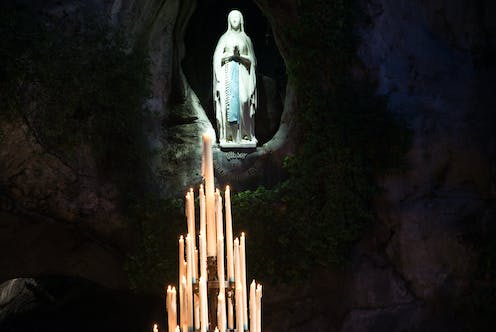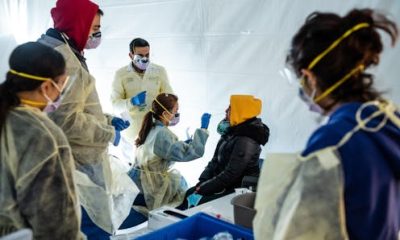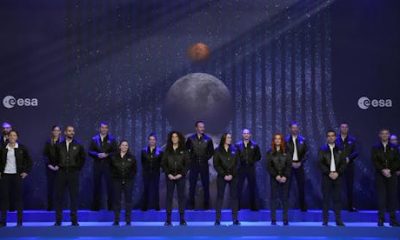
The shrine at Lourdes, France, where the Virgin Mary is venerated as ‘Our Lady of Lourdes,’ following several apparitions reported in 1858. LandFoto/iStock / Getty Images Plus
The Vatican recently announced its plan to set up an “observatory” at one of its several academic institutions, the Pontificia Academia Mariana Internationalis, to investigate claims of apparitions and other mystical phenomena attributed to the Virgin Mary.
As a scholar of global Christianity whose first book focused on apparitions and miracles of Mary in the modern Philippines, I’ve spent years studying the ins and outs of how the Catholic Church authenticates apparitions and the impact of these decisions on devotion to the Virgin Mary. I believe that the creation of this office signals a major shift in how apparitions of Mary have been evaluated and authenticated in modern times.
Contrary to depictions in popular media that show the Vatican as the first and only arbiter in these matters, the actual process almost always takes place at the local level and only rarely reaches the Holy See.
Official and unofficial judgment
The Council of Trent, held between 1545 to 1563, first gave bishops the authority to recognize new miracles or relics. In the 1970s, the Vatican’s Congregation for the Doctrine of the Faith, the office charged with defending and promulgating Catholic doctrine, established a set of norms prescribing how alleged apparitions should be judged at the local level.
However, most apparition claims don’t rise to the level of being investigated. Of the countless apparitions that have been reported throughout church history, only 25 have been approved by the local bishop, and 16 of those have been recognized by the Vatican.
Yet, throughout the Catholic world, hundreds of shrines commemorating a miraculous appearance of Mary enjoy devotional followings. What accounts for the difference between tacit and official church approval, and what is at stake when the church investigates an alleged sighting?
When personal revelations become public
Catholics the world over engage in deep relationships with Mary and the saints and take it for granted that their presence is real. In many places, furthermore, Catholic beliefs blended with Indigenous cultures and practices to produce apparition legends around which devotion has flourished for centuries.
Local priests and bishops navigate a fine line between popular religiosity and doctrinal orthodoxy. They readily accept diversity in how believers venerate Mary. But they also must remain vigilant against phenomena and messages that contradict the church’s teachings and threaten to undermine their authority. For many supernatural claims, the tipping point for investigation comes when a limited experience turns into a mass phenomenon.
A statue of the Virgin Mary outside the Sariaya Church in Quezon Province, Philippines.
Mariano Sayno/Moment
To take two examples from my research in the Philippines: In Quezon City, northeast of Manila, in the early 2000s, a neighborhood group that met weekly to pray the rosary was led by a woman who, while in trance, claimed to channel the Virgin Mary. Although officials from the Archdiocese of Manila were aware of the group’s activities, they left them alone, since their devotional practice had little impact beyond their immediate circle, and the content of Mary’s messages gave no cause for concern.
By contrast, after tens of thousands of people journeyed to the small Philippine coastal town of Agoo, in the northwestern province of La Union, to witness an appearance of Mary foretold by the visionary Judiel Nieva in March 1993, the presiding bishop immediately formed an official commission to investigate. Two years later, the commission declared it a hoax.
The difference between how local church authorities treated the two cases came down to the scale of the phenomenon, whether profit was made from people’s beliefs, and the content of the messages allegedly spoken by Mary. As with most apparitions found “not worthy of belief” – that is, not supernatural in origin – the Agoo phenomenon eventually died down.
Who determines devotion?
Occasionally, however, devotees remain steadfast in their belief that Mary appeared despite a negative judgment from the Catholic Church. For example, the devotional figure of Mary as the “Lady of All Nations,” a title associated with the visions of Dutch woman Ida Peerdeman, who claimed to have sighted the Virgin 56 times between 1945 and 1959, maintains a robust global following to this day. This is in spite of the fact that Dutch bishops and the Vatican’s doctrinal office have urged Catholics not to promote the apparitions associated with that particular title.
Likewise, in Lipa, the Philippines, there was in the 1990s a revival of devotion and belief that Mary had appeared to a Filipino novice of the religious order of the Carmelites in 1948. The devotion continued even though a commission of Filipino bishops investigated the phenomenon and declared that it “excluded any supernatural intervention” in 1951.
In both cases, popular support for the apparitions influenced sitting bishops to reconsider, and even overturn, a previously negative judgment.
But the bishops’ approval didn’t last long. Asserting the hierarchy of the Catholic Church, the Vatican’s doctrinal office stepped in to uphold the original rulings that the apparitions were not authentic. Even so, many devotees remain undeterred in their belief.
Balancing act
According to the proposed Vatican observatory’s president, the Rev. Stefano Cecchin, the new office will serve both academic and pastoral purposes, acting as a centralized task force for the systematic and multidisciplinary study of apparition claims worldwide.
It remains to be seen how precisely they will coordinate with local bishops who have until now enjoyed the authority to determine whether the mother of God appeared in their jurisdiction.
For those of us observing from the outside, the new observatory is an intriguing development in the long history of balancing the universal claims of the Catholic Church with the myriad expressions of local devotion and belief.
Deirdre de la Cruz does not work for, consult, own shares in or receive funding from any company or organization that would benefit from this article, and has disclosed no relevant affiliations beyond their academic appointment.
Advertisement

Advertisement
Contact Us
If you would like to place dofollow backlinks in our website or paid content reach out to info@qhubonews.com











